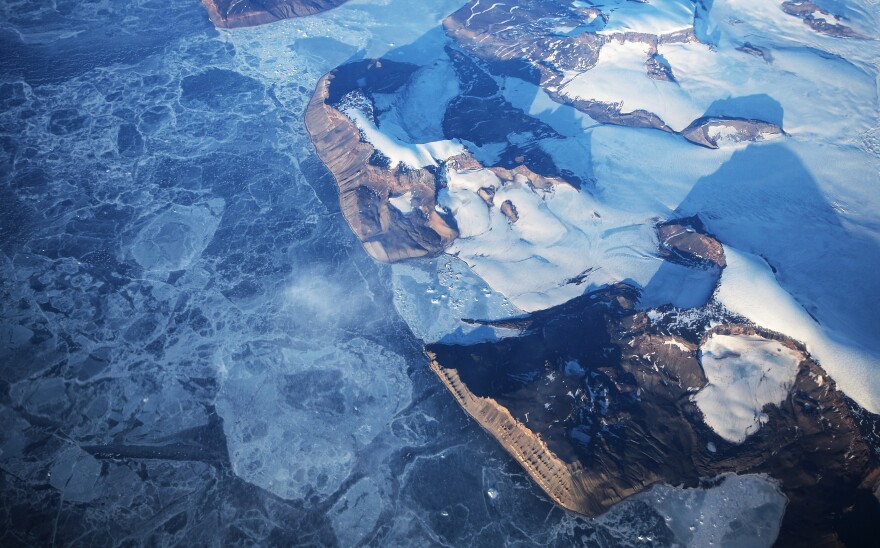A trio of new scientific analyses about the loss of ice in Antarctica paint a picture of a continent in trouble. Sea ice is disappearing, gigantic portions of the West Antarctic ice sheet are crumbling and even relatively stable East Antarctica is showing worrying changes.
That's a problem for humanity.
Let's begin with the sea ice. Each winter, the ocean water around Antarctica freezes. Because Antarctica is in the Southern Hemisphere, this happens during North American summer months – deep winter in Antarctica is in July, August and September.
At its most expansive, the sea ice covers an area the size of Antarctica itself, doubling the size of the frozen continent.
But the winter sea ice has been shrinking, in part because ocean water is warmer due to climate change. And this year there was less ice than ever before, going back to when satellites started tracking annual ice extent around 1980.
On September 10th, Antarctica's sea ice reached its largest extent of the year, but it was far smaller than average sea ice in decades past. In fact, it was nearly 350,000 square miles smaller than the previous record smallest amount, measured in 1986, according to a recent analysis by the National Snow and Ice Data Center, a research center at the University of Colorado, Boulder that is also affiliated with the federal government.
Loading...
Disappearing sea ice is a problem for lots of reasons. While it doesn't directly add any extra water to the ocean, missing sea ice does contribute to global sea level rise in other ways. The sea ice around Antarctica shields glaciers on land, and massive ice shelves that extend out into the water, from storms and above-freezing ocean water. Without that protection, that ice can melt more quickly, and that leads to more sea level rise.
And it's difficult for sea ice to recover after a bad year like this one. The water that doesn't freeze — the exposed ocean water — absorbs more heat than ice does, and that makes it more difficult for ice to re-form the next year.
"There is growing evidence that the Antarctic sea ice system has entered a new regime, featuring a much stronger influence of warm ocean waters limiting ice growth," scientists at the National Snow and Ice Data Center write in their analysis of this year's record-shattering low sea ice extent.
Antarctica's glaciers are also melting rapidly, and humans have no choice but to adapt
New research also raises the alarm about how Antarctica's enormous ice shelves and glaciers are responding to a warming world.
The West Antarctic ice shelf is the part of Antarctica that is melting most rapidly in response to climate change. It contains enough water to raise global sea levels by about 10 feet.
Scientists have warned for decades that, once the ice in West Antarctica begins to disintegrate, it will gain momentum and be very difficult, if not impossible, to reverse within a human lifetime. A new study finds that the runaway melting process is already underway.
The rate of ice melt and ocean warming in a crucial part of West Antarctica is three times what it was in the 20th century, according to the study published in the journal Nature Climate Change this week.

And when the authors used a computer to simulate what would happen if humans immediately slashed greenhouse gas emissions, they found it would have basically no effect on the rate of melting in West Antarctica for the rest of the century.
"It appears that we may have lost control of the West Antarctic ice shelf melting over the 21st century," says Kaitlin Naughten of the British Antarctic Survey and one of the authors of the study. "Our actions today likely will make a difference further down the line, in the 22nd century and beyond, but that's a time scale that probably none of us here will be around to see."
Previous studies have come to similar conclusions, although this is the first major study to simulate both ice and ocean changes in West Antarctica. The authors note that, while it may be too late for emissions reductions to save large areas of ice in West Antarctica, they are not predicting that the entire West Antarctica ice shelf will collapse in the next century. And it is not too late to protect the even-more-massive East Antarctic ice sheet.
"This is one glimmer of hope," says Naughten. "West Antarctica is much smaller than East Antarctica. And East Antarctica we think is pretty stable [and] is likely to stay so."
However, a separate study published this week in the journal Science Advances suggests that massive glaciers in East Antarctica could also melt more quickly than previously thought, as warm ocean water mixes with meltwater under the ice. While scientists expect East Antarctica to remain relatively stable for 100 years or more, the new discovery could also have implications for how quickly glaciers disintegrate in West Antarctica.
Taken together, the new research paints a picture of a continent that is poised to drive multiple feet of sea level rise in the coming decades, and could cause catastrophic sea level rise longer term if humans don't shift away faster from fossil fuels.
"In this context, courage looks like adaptation," says Naughten, noting that cutting emissions is not enough on its own. "If we can plan ahead to reduce human suffering and to save human lives, that's better than closing our eyes until the ocean's at our doorstep."
Some American cities are already beginning to prepare for multiple feet of sea level rise this century, in part because official sea level rise predictions from the National Oceanic and Atmospheric Administration already factor in some Antarctic melting. Disappearing ice in West Antarctica disproportionately drives sea level rise on the East and Gulf Coasts of the United States, because of ocean currents and other ocean and ice dynamics.
Copyright 2023 NPR. To see more, visit https://www.npr.org. 9(MDAwMTM1NDgzMDEyMzg2MDcwMzJjODJiYQ004))



